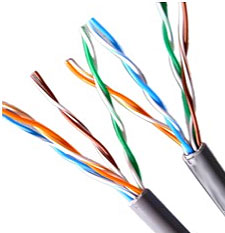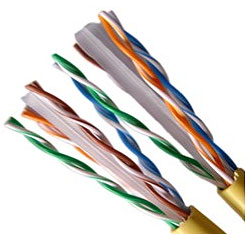Unshielded Twisted Pair (UTP) cable is by far the most popular cable around the world. UTP cable is used not only for networking but also for the traditional telephone (CAT1). There are more than six different types of UTP categories and, depending on what you want to achieve, you would need the appropriate type of cable. CAT5E is the most popular UTP cable, it came to replace the well known coaxial cable which was not able to keep up with the continuous growth for faster and more reliable tele and data communication networks.
| What is the difference between the popular CAT5E communications cable and CAT6? |
|
|
||
| Product Name | CAT5E UTP (Unshielded Twisted Pair) Cable |
CAT6 UTP (Unshielded Twisted Pair) Cable |
| CAT5Evs.CAT6 |  |
 |
| Speed | 10 BASE-T 100 BASE-T – Fast Ethernet 1000 BASE-T – Gigabit Ethernet |
10 BASE-T 100 BASE-T – Fast Ethernet 1000 BASE-T – Gigabit Ethernet 10G BASE-T – 10 Gigabit Ethernet |
| Frequency | 100MHz | 250MHz |
| Category 5 – CAT5 |
| Category 5 transmits at 100MHz frequencies, providing a rated line speed of up to 100Mbit/s and a max cable segment length of 100 meters. Most Category 5 cables, designed for early networks, only used two twisted pairs. Older Category 5 cables continue to make up the bulk of the world’s network infrastructure. |
| Category 5E – CAT5E |
| An improved specification to Category 5 was later introduced. By reducing noise and signal interference, CAT5E was capable of increasing rated transfer speeds to 350 Mbit/s over 100 meters. The new standard also required all cables to include four twisted pairs (all eight contacts). An optimized encoding scheme allows up to 50-meter lengths of CAT5E cable to perform at, or near, Gigabit Ethernet (1000BASE-T) speeds. |
| Category 6 – CAT6 |
| The mainstream adoption of Gigabit Ethernet (1000BASE-T) required new industry-standard cables capable of transmitting at a higher frequency of 250 MHz. Category 6 cable uses thicker-gauge wire, increased shielding, and more pair twists per inch to reduce signal noise and interference. The tighter specifications guarantee that 100-meter runs of Category 6 are capable of 1000 Mbit/s transfer speeds. 10-Gigabit Ethernet speeds are achievable when reducing cable lengths to less than 50 meters. |
| Category 6E – CAT6E |
| Category 6 Enhanced (6E) is an augmented specification designed to double transmission frequency to 500 MHz. By wrapping CAT6E in grounded foil shielding, full 10-Gigabit Ethernet speeds can be reached without sacrificing the max cable length of 100 meters. |
Details of all Communication Cables Categories:
*The code before the slash designates the shielding for the cable itself, while the code after the slash determines the shielding for the individual pairs:
U = Unshielded
F = Foil shielding
S = Braided shielding (outer layer only)
TP = Twisted Pair
FTP = Foiled Twisted Pair
| What is the difference between the Shielded and Unshielded Twisted Pair? |
Shielded Twister Pair (STP) cables have additional shielding material that is used to reduce external interference. The shield also reduces the emission at any point in the path of the cable. UTP cables provide much less protection against such interference and the performance is often degraded when interferences or disturbances are present. Both types of cables, however, have some protection to interference due to the twisted pair design of the conductors.
The drawback of STP cable is that it will increase the total cost of an installation. STP cables are more expensive due to the shielding, which is an additional material that goes into every foot of the cable. The shielding also makes the cable heavier and stiffer. Thus, it is more difficult to handle.
| Why the ‘twist’ in twisted pair? |
Twisted pair are twisted together for the purposes of canceling out electromagnetic interference (EMI) from external sources; for instance, electromagnetic radiation from unshielded twisted pair (UTP) cables, and crosstalk between neighboring pairs. The advantage of twisting is that all wires are equally affected by external influences, so the unwanted signals are canceled out. The role of twisting is to minimize the interferences from external magnetic fields.
| The Features and Benefits of CAT5E and CAT6 Communications Cable: |
CAT5E Ethernet Cable
-
Category-5E Unshielded Twisted Pair (UTP) Cable
-
High-Performance Data Communications Cable
-
Suitable for 350MHz High-Speed Data Applications
-
Suitable for Gigabit Ethernet, Fast Ethernet and 155Mbps TP-PMD/CDDI
-
4-Pair – Easily Identified Color-Striped Pairs
-
AWG24 Solid Annealed Bare Copper Conductors
-
Excellent Attenuation and Crosstalk Characteristics
-
Nominal Impedance 100Ω±15%
-
DC Resistance <9.38Ω/1000ft
-
Mutual Capacitance <0.9pF/ft @ 1 kHz
-
Flame Retardant – Type CM CMG, CMH
-
Suitable for Indoor Installations
-
Exceeds EIA/TIA 568, UL, CSA and ISO/IEC 11801 specifications
-
UL/cUL or ETL Listed
- Supplied in 1000´ Pull Boxes or Reel in a Box
CAT6 Ethernet Cable
- Category-6 Unshielded Twisted Pair (UTP) Cable
Ultra-High-Performance Data Communications Cable - Suitable for 550MHz High-Speed Applications, Critical Network Applications, Gigabit Ethernet, Fast Ethernet, Broadband Audio and Video, 155Mbps ATM, and 100Mbps TP-PMD/CDDI,NEXT, ELFEXT and RL Bandwidth Compliant
- 4-Pair – Easily Identified Color-Striped Pairs
- PE pair separator minimizes pair motion
- AWG23 Solid Annealed Copper Conductors
- 100% Tested Wiring Sequence and Continuity
- Excellent Attenuation and Crosstalk Characteristics
- Impedance 100?±15% – DC Resistance 23?/1000´
- Mutual Capacitance 14pF/ft Maximum @ 1kHz
- Velocity of Propagation 68%
- Flame Retardant – Type CM CMH, CMR
- Suitable for Indoor Installations
- Exceeds Category-6 ANSI/TIA/EIA 568B.2-1 and ISO/IEC 11801 standards and all proposed Category-6 requirements for high-speed, full duplex, parallel transmission protocols
- UL/cUL 1685, CSA, ETL Listed
- Supplied in 1000´ Pull Boxes or Reel in a Box

